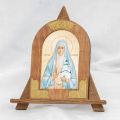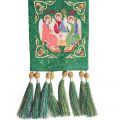This website uses cookies to ensure you get the best experience on our website. Read more
The Clerical Vest: A Garment Of Convenience
 29Mar
29MarLet me take a few minutes to discuss some of the strengths of a garment that you may be less familiar with, but which has been widely appreciated by clergy members. It goes by the name "clergy vest" in our online catalogue and also can be known as "short cassock". It went through an interesting evolution before becoming common in clerical practice.
Origins
A canon adopted by the Sixth Ecumenical Council (Canon 27) commands that every clergy member must wear proper clothing. By tradition, the undercassock and cassock have been the appropriate garments. Depending on the context, they have undergone an evolution. In Russia, for example, shorter versions of the cassock (also called the half-cassock) came into use at one point, mostly worn when travelling during the wet season. A similar garment became popular in other areas where road conditions deteriorated as the seasons changed. Its Greek name, the short cassock, sheds light on the direction of its transformation.
There is a theory that the short cassock, or kontorasson, owes its present design to the rapid spread of the automobile among the Greek clergy. The sheer length of the classical cassock and its wide sleeves made it very uncomfortable for clerics to get into their cars, so its modified version came with no sleeves and looked more like an extended vest. Despite its plausibility, the theory does not rule out the possibility of movement in the opposite direction, namely, of clerical clothing adopting the practical features of secular garments.
In some dioceses, there is disagreement about whether it is appropriate for laypeople to wear clergy vest: some think it is unacceptable, while others take a more neutral position. Male and female monastics, who also wear cassocks, have adopted the short cassock as a habitual part of their wardrobes.
 The service book fits well in a vest pocket
The service book fits well in a vest pocket
Advantages
1) It is much more convenient to take the book from the lower pocket of the clergy vest during a worship service while keeping it in the pocket of the long cassock when not serving. With experience, easy access to the Hieratikon becomes less relevant, but I found it extremely helpful in my first years. This privilege is not available to a priest in a liturgy (priest sticharion/podriznik blocks access to the pockets) but is feasible at other services. There is even enough room for a small-sized Trebnik.
 The service book can be easily taken out and put back in the pocket of the vest
The service book can be easily taken out and put back in the pocket of the vest
2) A key advantage of a clergy vest is that it provides extra warmth by adding a layer of clothing. It could be a lightweight garment, with or without lining (lined articles are better at keeping their shape), or a warmer item for colder temperatures. It can be worn over a cassock, under a sticharion, or even under the inner cassock when necessary. However, a clergy vest can be much easier to remove in a warm room than, say, a sweater from under an inner cassock.
3) In milder climates, where keeping warm is less relevant, one might appreciate the availability of an extra set of pockets in a short, lightweight cassock. Admittedly, long cassocks come with large pockets, but it could also be more convenient to put the things one needs to have at hand into different pockets than keeping them all in one. Digging into a deep pocket to find the exact thing you need can be time-consuming and unsightly.
4) A clergy vest is also a good match with a Greek cassock worn on a visit to the archbishop or for other important occasions. The cut and wide sleeves with large arm openings enable easy access to the pockets. One has easy access to all the essential things (even if they protrude from the pockets) while maintaining a respectable look and eliminating the need to carry a bag or purse that can easily be left behind.
5) To keep your hands warm in the pockets of a clergy vest appear more comfortable and appropriate than keeping them in the pockets of the inner cassock.
6) Finally, a handkerchief can be used more easily and discreetly when one has a cold.
On a personal note, I first discovered the advantages of a clergy vest while I was still a seminary student. Subdeacons and chanters were allowed to wear them, but not the rank-and-file students. I ordered myself a long cassock and a clergy vest as soon as I could. They came as a single set, in the same design and material. I am still using both pieces. I wear the silk clergy vest with lining during the warmer months (taking it off on very hot days). The cashmere clergy vest is reserved for the winter season.
One notable trend in the evolution of the clergy vest is that it is gradually taking on a role of its own, irrespective of its origins or symbolism. In some male monasteries, novices and labourers wear black clergy vest for greater uniformity. The Brotherhood choir at Saint Elisabeth Convent wears them for concerts and worship services.
 Brother's choir of St.Elisabeth Convent performs in vests at a concert
Brother's choir of St.Elisabeth Convent performs in vests at a concert
We asked sister Tatiana who deals with your sewn orders to share what options do you have while ordering a clergy vest:

Our customers can select:
- the desired length of the item (where applicable);
- the preferred material (silk, polyester, flax, cotton, viscose, wool, or thick cashmere for colder climates);
- the size of the lower pockets (to accommodate whatever objects you may require) and the number of chest pockets, if any.
- slits on the sides (for access to the undercassock pockets)
- lining (improves the appearance of the item but adds a layer of fabric, which may be an issue in hotter climates)
- colour (black, grey, brown, blue, beige, white, etc.)
- decorations and ornaments (for example, stitching or embroidery).
In general, clergy vest offer clear advantages. If you already own one, you might agree. If not, what better occasion to try it out?
We wish you all the best; may the Lord grant you spiritual and physical strength and His other plentiful blessings.

























